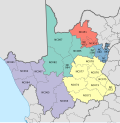Gamagara Local Municipality
Gamagara | |
|---|---|
 Location in the Northern Cape | |
| Coordinates: 27°40′S 23°00′E / 27.667°S 23.000°E | |
| Country | South Africa |
| Province | Northern Cape |
| District | John Taolo Gaetsewe |
| Seat | Kathu |
| Wards | 8 |
| Government | |
| • Type | Municipal council |
| • Mayor | Henriette du Plessis[1] (DA) |
| Area | |
| • Total | 2,619 km2 (1,011 sq mi) |
| Population (2011)[3] | |
| • Total | 41,617 |
| • Density | 16/km2 (41/sq mi) |
| Racial makeup (2011) | |
| • Black African | 55.0% |
| • Coloured | 28.7% |
| • Indian/Asian | 0.6% |
| • White | 14.0% |
| First languages (2011) | |
| • Afrikaans | 53.9% |
| • Tswana | 33.7% |
| • English | 3.6% |
| • Sotho | 1.4% |
| • Other | 7.4% |
| Time zone | UTC+2 (SAST) |
| Municipal code | NC453 |
Gamagara Municipality (Afrikaans: Gamagara Munisipaliteit; Tswana: Mmasepala wa Gamagara) is a local municipality within the John Taolo Gaetsewe District Municipality, in the Northern Cape province of South Africa.
The name Gamogara is of Setswana origin. The municipality is named after a dry river which was in turn named after a man called Mogara of the Makwere clan (Batlhaping). During the early days of exploration, Mogara was the first person to settle in this part of the country. After 1887, the area became dominated by White farmers who then changed the name as they were unable to pronounce it correctly. Hence it was called Gamagara instead of Gamogara. The name is derived from a dry river that ran from Dibeng to join the Kuruman (Segonyana) river at Dikgatlong tsa ga Kganyile. Incidentally, this is the route the Ba ga Motlhware followed on their way to their headquarters, Maje a Mokhothu (Langeberg).[5]
Main places
The 2001 census divided the municipality into the following main places:[6]
| Place | Code | Area (km2) | Population |
|---|---|---|---|
| Dibeng | 32401 | 8.58 | 4,023 |
| Dingleton | 32402 | 1.56 | 2,866 |
| Ditloung | 31903 | 0.62 | 3,044 |
| Kathu | 32404 | 8.53 | 8,247 |
| Olifantshoek | 31907 | 3.51 | 3,985 |
| Remainder of the municipality | 32403 | 2,449.38 | 1,048 |
Politics
The municipal council consists of fifteen members elected by mixed-member proportional representation. Eight councillors are elected by first-past-the-post voting in eight wards, while the remaining seven are chosen from party lists so that the total number of party representatives is proportional to the number of votes received. In the election of 1 November 2021 no party obtained a majority of seats on the council. The following table shows the results of the election.[7][8]
| Gamagara local election, 1 November 2021 | ||||||||
|---|---|---|---|---|---|---|---|---|
| Party | Votes | Seats | ||||||
| Ward | List | Total | % | Ward | List | Total | ||
| African National Congress | 4,973 | 4,961 | 9,934 | 43.1% | 6 | 1 | 7 | |
| Democratic Alliance | 3,931 | 4,005 | 7,936 | 34.4% | 2 | 3 | 5 | |
| Gamagara Community Forum | 1,556 | 1,503 | 3,059 | 13.3% | 0 | 2 | 2 | |
| Economic Freedom Fighters | 861 | 798 | 1,659 | 7.2% | 0 | 1 | 1 | |
| Freedom Front Plus | 220 | 218 | 438 | 1.9% | 0 | 0 | 0 | |
| South African Royal Kingdoms Organization | 6 | 36 | 42 | 0.2% | 0 | 0 | 0 | |
| Total | 11,547 | 11,521 | 23,068 | 8 | 7 | 15 | ||
| Valid votes | 11,547 | 11,521 | 23,068 | 98.7% | ||||
| Spoilt votes | 146 | 151 | 297 | 1.3% | ||||
| Total votes cast | 11,693 | 11,672 | 23,365 | |||||
| Voter turnout | 11,707 | |||||||
| Registered voters | 23,135 | |||||||
| Turnout percentage | 50.6% | |||||||
References
- ^ Hoo, Sandi Kwon (2023-05-29). "New DA mayor for Gamagara Municipality". DFA. Retrieved 2023-05-30.
- ^ "Contact list: Executive Mayors". Government Communication & Information System. Archived from the original on 14 July 2010. Retrieved 22 February 2012.
- ^ a b "Statistics by place". Statistics South Africa. Retrieved 27 September 2015.
- ^ "Statistics by place". Statistics South Africa. Retrieved 27 September 2015.
- ^ South African Languages - Place names
- ^ Lookup Tables - Statistics South Africa[permanent dead link]
- ^ "Results Summary - All Ballots" (PDF). Electoral Commission of South Africa. 8 November 2021. Retrieved 12 November 2021.
- ^ "Seat Calculation Detail" (PDF). Electoral Commission of South Africa. 8 November 2021. Retrieved 12 November 2021.
External links
- All articles with dead external links
- Articles with dead external links from January 2017
- Articles with permanently dead external links
- Articles with short description
- Short description is different from Wikidata
- Coordinates on Wikidata
- Articles containing Afrikaans-language text
- Articles containing Tswana-language text
- Local municipalities of the John Taolo Gaetsewe District Municipality

